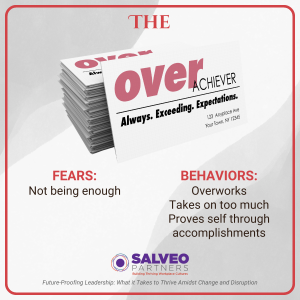“Being ‘crazy busy’ is not a badge of honor; it’s a badge of armor and self-protection.”
— Dr. Rosie Ward
In our research with 250 leaders across various industries, the Overachiever Faulty Program emerged as the second-most common pattern, appearing in 35% of the leaders we analyzed. It looks admirable from the outside—fast execution, relentless drive, consistently high output. However, when achievement becomes the primary means of proving our worth (rather than expressing it), performance gains plateau, teams stagnate, and leaders burn out.
This post builds on the foundation we introduced in our first article, Why Leaders Get Stuck: The Stuckness Zone™ and Faulty Programs. If you haven’t read that one yet, we recommend starting there—it provides the context for how faulty programs are formed, why they keep us stuck, and why upgrading them is essential to future-ready leadership.
How the Overachiever Program Shows Up
At first glance, leaders running the Overachiever appear highly capable—responsive, productive, constantly in motion. Underneath is a fear-driven equation: worth = work. That wiring shows up in day-to-day leadership behaviors, especially when the stakes are high:
- Overworks and overcommits. Says yes by default; equates availability with value. Proves value through output.
- Prioritizes visible productivity over strategic focus and relationships.
- Takes on too much. Steps in to fix, re-do, or “rescue” (all in the spirit of proving their value and how indispensable they are) instead of delegating and enabling.
- Treats recovery as optional. Downtime feels unsafe or “lazy,” so calendars stay packed.
Leaders often tell us, “If I’m not visibly getting things done, I feel like I’m letting people down.” The fact that so many organizations celebrate overachieving tendencies only exacerbates this faulty program.
This isn’t a motivation problem. It’s self-protection: an attempt to outrun the fear of not being enough by doing more.

The Fears Driving the Overachiever
Beneath the busyness are powerful, often early-formed fears:
- Fear of not being enough. “My value is my accomplishments.”
- Fear of letting people down. “If I don’t take it on or work harder, others will think less of me.”
- Fear of appearing lazy or incompetent. “If I pause, I’ll be judged; people will think I’m not working hard enough.”
- Fear of not achieving. “Getting results is what ultimately matters.”
When the Overachiever is talking, the head trash sounds like:
- I have to work harder to prove myself and not let people down.
- Results are what ultimately matter. If I’m not achieving, what value do I have?
- I tend to take on more than I can handle.
- If I’m not achieving, what value do I have?
These fears are deeply human. Many leaders learned—at home, in school, or early in careers—that approval, safety, and belonging followed hard work and results. Over time, the brain fused identity with achievement.
The Costs of the Overachiever Program
While Overachiever tendencies are praised in many organizations, their hidden costs are significant.
For Leaders
- Exhaustion and depletion. Constant output without restoration.
- Stalled growth. Time for strategy, reflection, and learning gets crowded out.
- Reactive leadership. Firefighting replaces prioritization; presence erodes.
- Health and relationship strain. Bodies and bonds absorb the bill.
For Organizations
- Bottlenecked execution. Leaders become the doers; team capacity fails to scale.
- Underdeveloped talent. Delegation, coaching, and feedback give way to “I’ll just do it.”
- Erosion of accountability. Expectations are unclear because speed often takes precedence over alignment.
- False efficiency. Short-term throughput undermines long-term performance.
There’s also a predictable ripple effect. The Overachiever frequently travels with other programs—Perfectionist, People-Pleaser, and Control Freak—and often spikes the “cousin” patterns (Dropout, Fraud, Protector) when fear surfaces. The result: more doing, less developing.
Want to dig deeper? Download our free research paper, Future-Proofing Leadership: What It Takes to Thrive Amidst Change and Disruption, to explore the findings from our study of 250 leaders across industries.
Where Leaders Get Stuck (Our Data)
When the Overachiever is active, even highly motivated leaders struggle to make progress on adaptive goals—the ones that require transformation and mindset shifts, not just new tips or tools.
From our analysis:
- 63% struggled to achieve mindset-related improvement goals when this program was running.
- Four hot spots consistently surfaced:
- Emotional Regulation (30%) — Pausing, staying curious, and responding calmly feels “too slow.”
- Growth Feedback (24%) — “Saving the work” replaces developing others.
- Fostering Accountability (24%) — Clarity, alignment, and follow-through take a back seat to speed.
- Setting Boundaries (24%) — Saying no threatens identity when worth is tied to output.
Bottom line: What appears to be dedication is often self-defeating overfunctioning.
Why We Get in Our Own Way
Two forces reinforce the Overachiever:
- Early conditioning. Love, pride, or safety were felt to be contingent on performance.
- Modern reward systems. Many workplaces celebrate visible busyness and immediate results while overlooking the costs and the culture signals that it sends.
Leaders aim at the right targets—better coaching, clearer accountability, calmer presence—but keep one foot on the brake because their inner operating system equates slowing down with losing value.
Breaking Free: The Upgrade Process
The goal isn’t to dull your edge—it’s to stop cutting yourself (and your team) with it. Upgrading the Overachiever moves you from proving your value to knowing your value and from solo speed to scalable outcomes.
1. Name It
Catch the pattern in real time and label it.
“I hear you, Overachiever. I don’t have to prove my worth by overfilling my calendar.”
Why it works: Naming interrupts autopilot and re-engages choice.
2. Own It
Map your personal expression and origin.
- Expression: When do you say yes reflexively? Where do you jump in rather than enable? How does busyness crowd out relationships and strategy?
- Origin: Identify 3–5 early experiences that taught you “value = achievement” or “safety = work harder.”
Why it works: Understanding dissolves shame and creates leverage for change.
3. Challenge It (Upgrade)
Rewrite the script with targeted experiments.
Replace the head trash. Swap it with new short, sticky truths (belief will eventually set in with practice):

Run micro-experiments. Collect data that slowly disproves the lies the Overachiever has sold you:
- Delegation sprints: Clarify decision rights, define “done,” and step back; appreciate the value you can bring by intentionally including and elevating others versus doing it yourself.
- Calendar truth-telling: Add prep, follow-up, strategy, and recovery blocks—then protect them. Start being realistic about your bandwidth and recognize other ways you can add value beyond overbooking your calendar.
- Unplug pilots: Start with one evening a week and gradually extend to weekends and vacations. Start to appreciate your effectiveness and impact (and value) when you tend to your relationships rather than just getting things done.
- Feedback interviews: Ask 5–7 trusted people:
- “What do you value about me?” (Listen for elements beyond achievement.)
- “What’s the impact when I’m overly focused on getting things done?” (Notice the costs to trust and growth.)
- “What do you value about me?” (Listen for elements beyond achievement.)
Because the Overachiever is so pervasive—and frequently rewarded—upgrading it will be an ongoing process. Architect accountability to support you along the way, so you’re not relying solely on willpower. For example, perhaps having visual prompts on your computer, such as “Do I really have the capacity?” or “What’s the cost of taking this on?” can help you pause before adding more to your calendar.
If you have an administrative assistant who supports your calendar, enroll them to help protect your priorities and your time. Additionally, consider implementing a practice of weekly “stop doing” reviews for yourself and your teams, and start rewarding both focus time and recovery. These practices help create systems to fall back on and support you when your humanity gets the best of you.
Steps You Can Take
- Set a capacity cap. Define weekly limits for meetings and “doing” hours; treat them like a budget.
- Make strategy time non-negotiable. Create at least two protected blocks per week for reflection, ideation, and strategy-level work to help reduce some of the busyness and firefighting.
- Adopt a 24-hour rule for new commitments. Practice defaulting to pause and fully consider your capacity before agreeing to take on anything new.
- Model visible recovery. Normalize rest and focus time; celebrate behaviors that scale capacity, not just heroics.
These shifts send a clear cultural signal to others: We value outcomes, growth, and humanity—not performative busyness.
Moving Beyond the Overachiever
Upgrading this program isn’t a one-time event. Promotions, disruptions, and new seasons of life can reactivate the urge to prove. The primary difference after the upgrade is that resets are faster and more streamlined. You’ll notice sooner, name it sooner, and return to what works—without shame.
At Salveo Partners, our Courageous Leadership Program is designed to help leaders identify Faulty Programs, like the Overachiever, rewrite limiting stories, and build the systems and habits that enable sustainable, scalable performance.
What’s Next in This Series
This article is part of our ongoing series that unpacks the Faulty Programs that keep leaders stuck in the Stuckness Zone. In the next installment, we’ll explore a close companion to the Overachiever—the Perfectionist Faulty Program—and why chasing “just right” so often undermines learning, innovation, and trust.
Our aim is simple: normalize the messiness of being human, expose the invisible patterns holding leaders back, and provide actionable paths to help you—and your organization—thrive in a disruptive world.
Stay HUMAN. Stay connected. Stay safe. Show Up as a Leader.







